The Box and Goodies -
Intel’s boxes are usually very clean (bordering on plain) you have the electric skull on the front that has been with us since the times of the skulltrail platform (which were very fun to test out). You get a few of the typical badges and logos along with a short listing of the DZ77GA-70K’s features.

The back of the box has more to offer and goes into some specifics about what you get as well as a nice image of the board with the major components/features detailed.
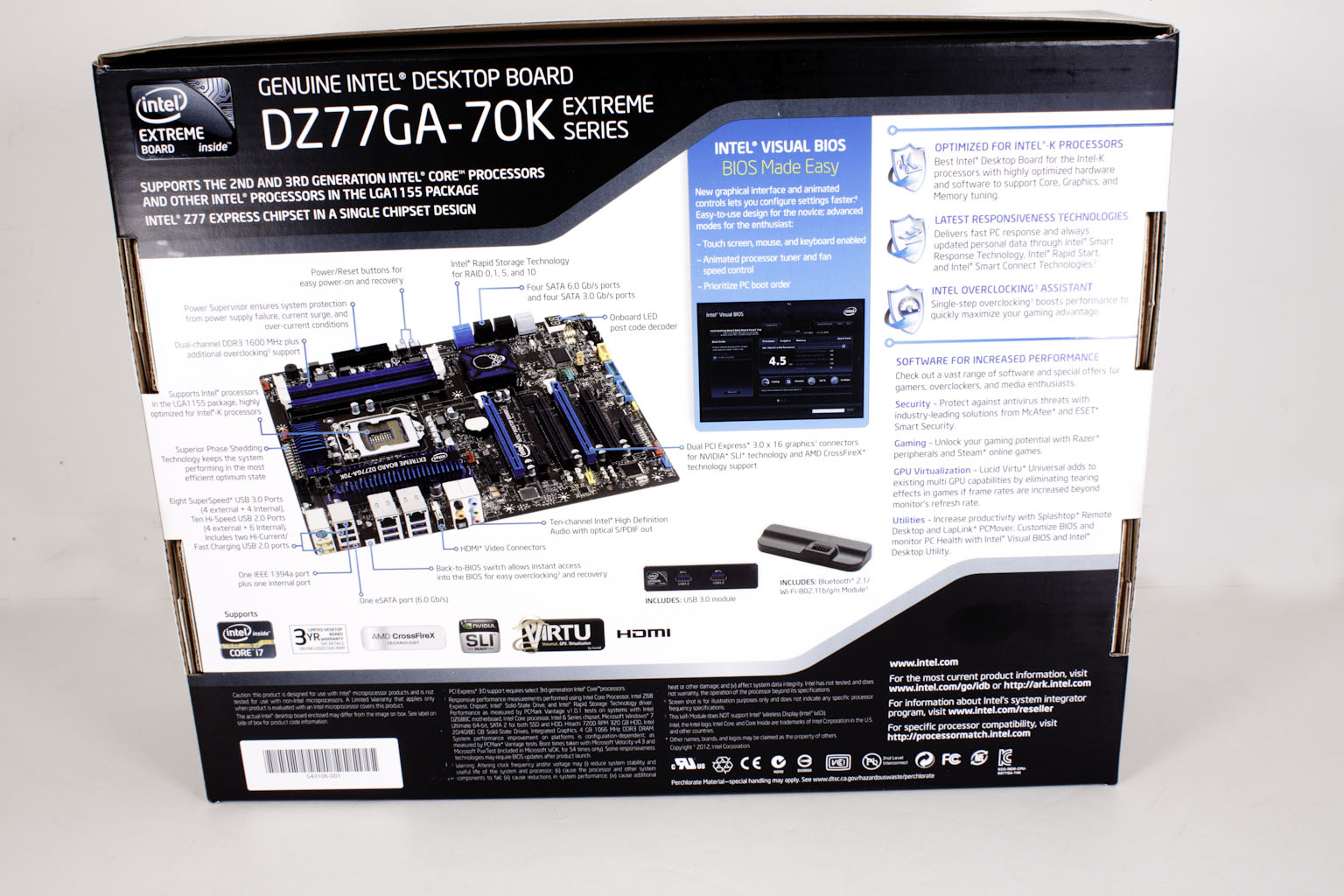 |
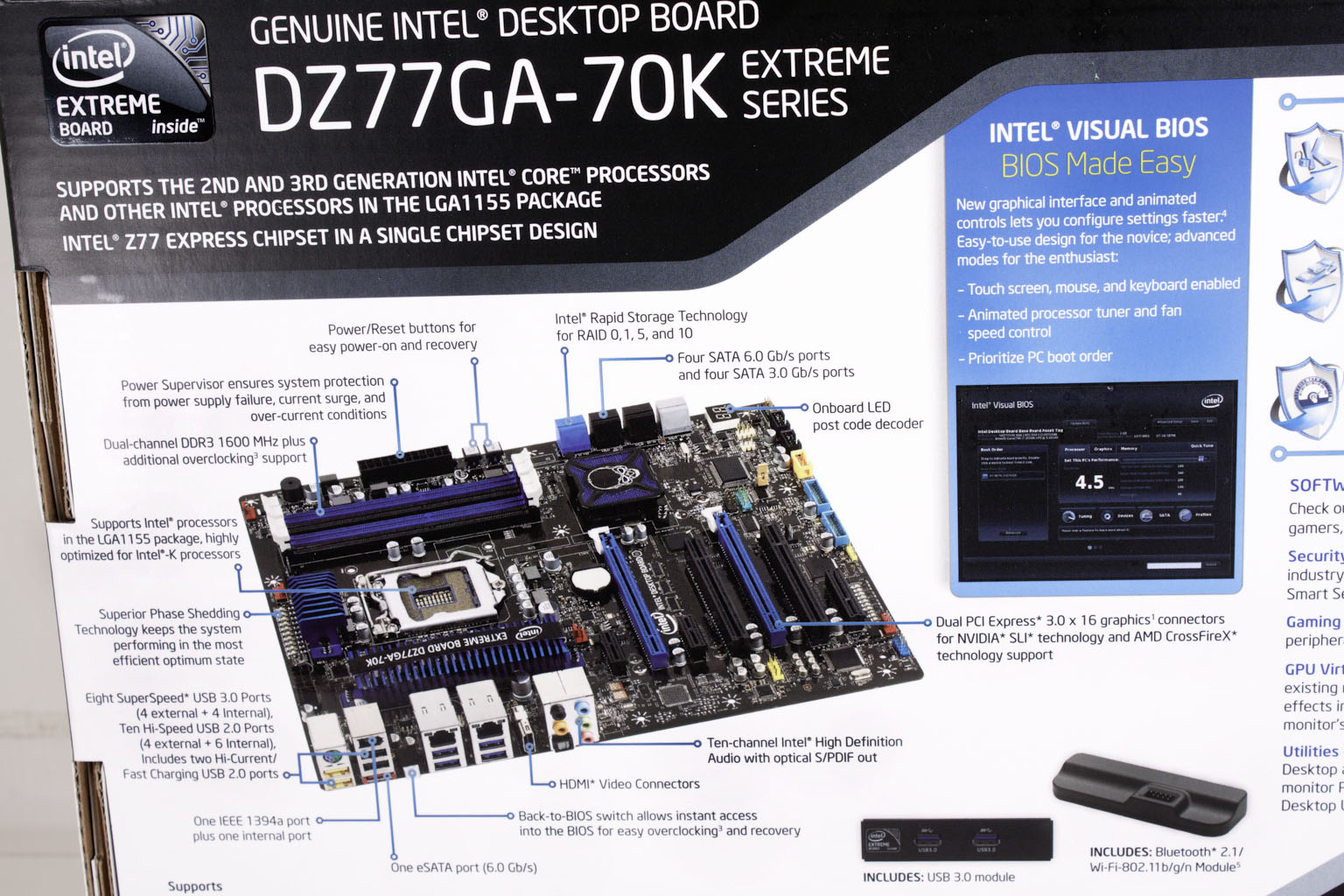 |
Inside the box you will get a front USB 3.0 panel, a wireless/Bluetooth module (that plugs into an on-board USB header), a mouse pad, the I/O shield, quick start guide as well as a drivers DVD and manual. Our box did not contain these items (so they are not pictured here), but we were able to get them direct from Intel.
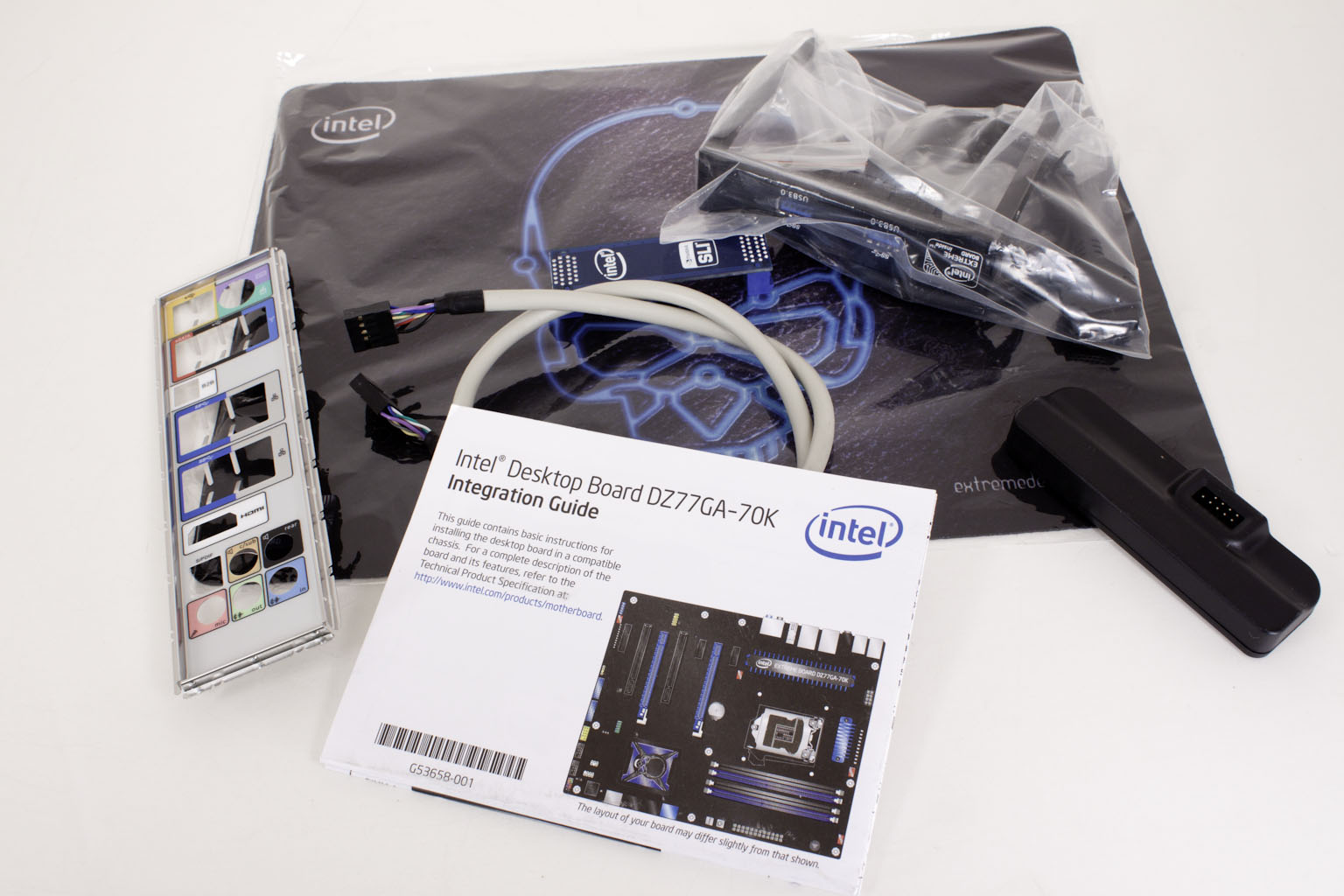
That is really all that there is to the packaging so let’s move onto to the motherboard and see what it has to offer.
The Layout -
The layout of any motherboard is important. Even simple mistakes in component placement or the signal traces can cause major issued in performance and stability. With the ATX form factor we find that this is even truer; the devices we drop onto them demand more and cleaner power while the signal speeds push faster and faster No surprise here the DZ77GA-70K is an ATX style motherboard, but Intel has chosen to not pack it with too much. On many other standard ATX motherboards you can almost have too much going on which leads to instability and (at times) overheating. Here we find a clean layout which lends to a good looking board. Starting off at the top right of the board we find the typical RAM and power layout (24-pin ATX power, four RAM slots etc.). There are also power and reset buttons here for anyone that might want to use this on an open test bench (like us).
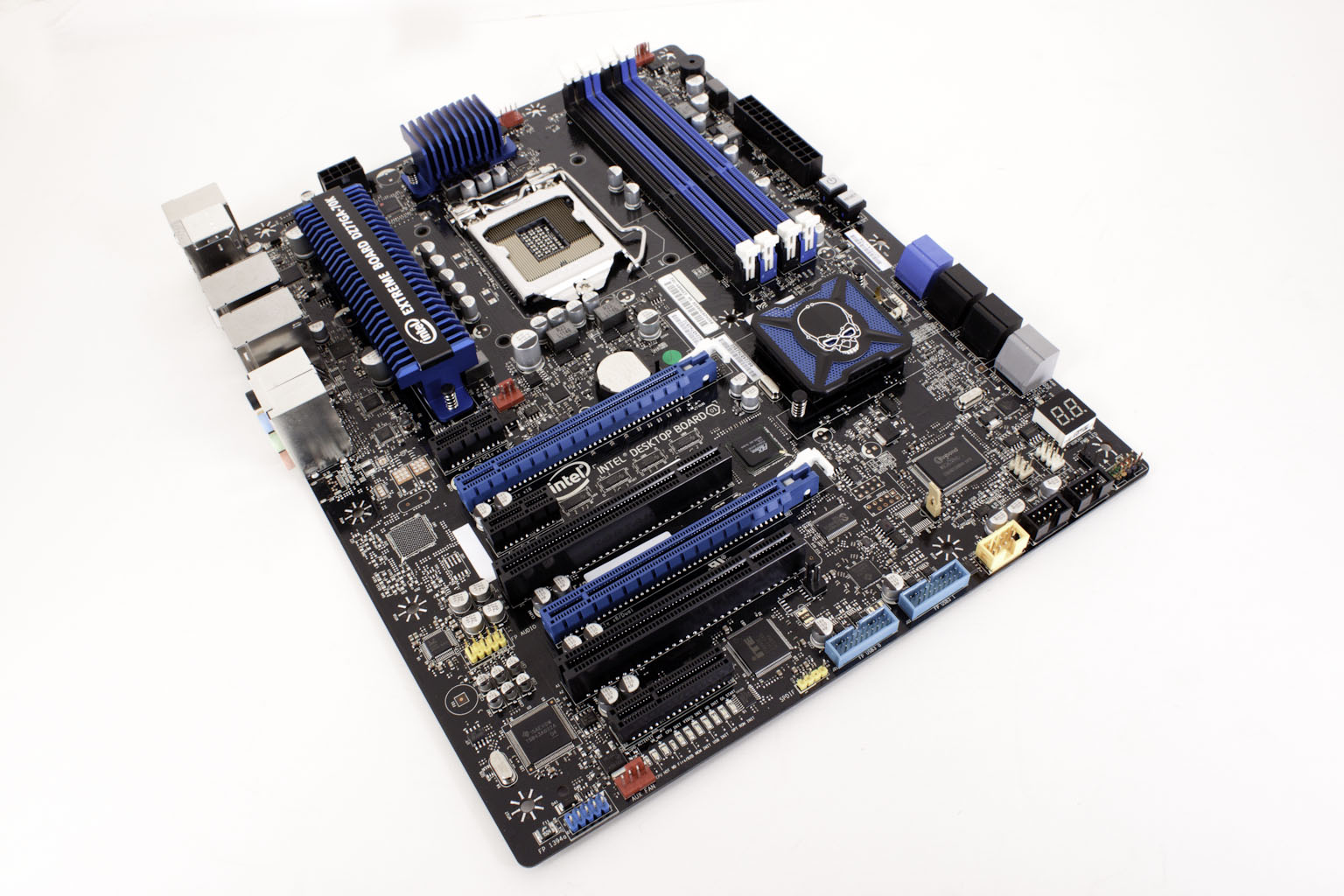
The CPU socket is of course an LGA 1155 socket so it will support both Sandy and Ivy Bridge CPUs. The cooling for the voltage regulation components looks like it might be a little small for any serious overclocking and without good airflow we would be concerned with pushing any kind of serious voltage through here. There are a couple of other items in this shot that we want to draw your attention to. If you look closely you can see the tracing layout from the CPU to the RAM slots, these are very well laid out and as we have mentioned in the past can make all the difference between stability and a ton of BIOS revisions. Beyond that you can see that the 8-pin Aux ATX power port has a little more room than on many motherboards (although we always recommend using an adapter cable) and Intel has dropped in a row of LEDs to indicate the power draw on the board. This last one is a nice touch as we know how much geeks love blinking green lights.
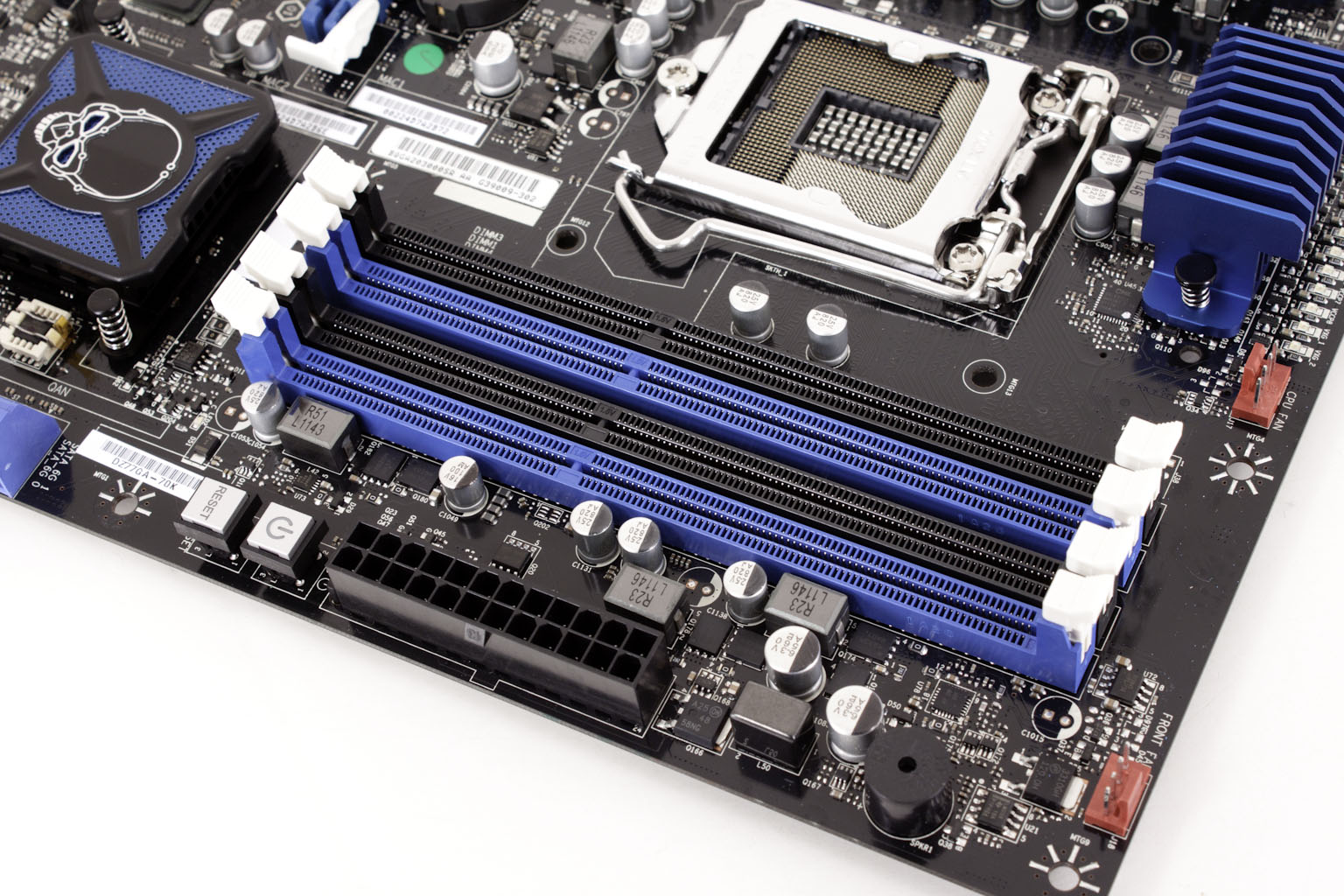 |
 |
For peripheral expansion you have two PCIe x16 mechanical slots both of which are x16 electrical as well. This does not mean you are going to get dual x16 with SLI or crossfire though (you will only get x8 at that point), but it is nice that you can use either one for full x16 single card performance. There are also two PCI 2.1 slots here which is interesting as the Z77 does not have any support for PCI. To get this you have to use a PCI controller chip (which is one of the reasons why there is a PLX bridge on the board as well). At the bottom of the board is an open ended PCIe x4 mechanical slot. This slot allows you to use a longer card in it, but you will only be able to use 1 PCIe lane for it. There are many cards that can support this, but you will want to make sure before you try it. Below this slot there is a series of LEDs that indicate when certain functions are active (again with the binky lights).
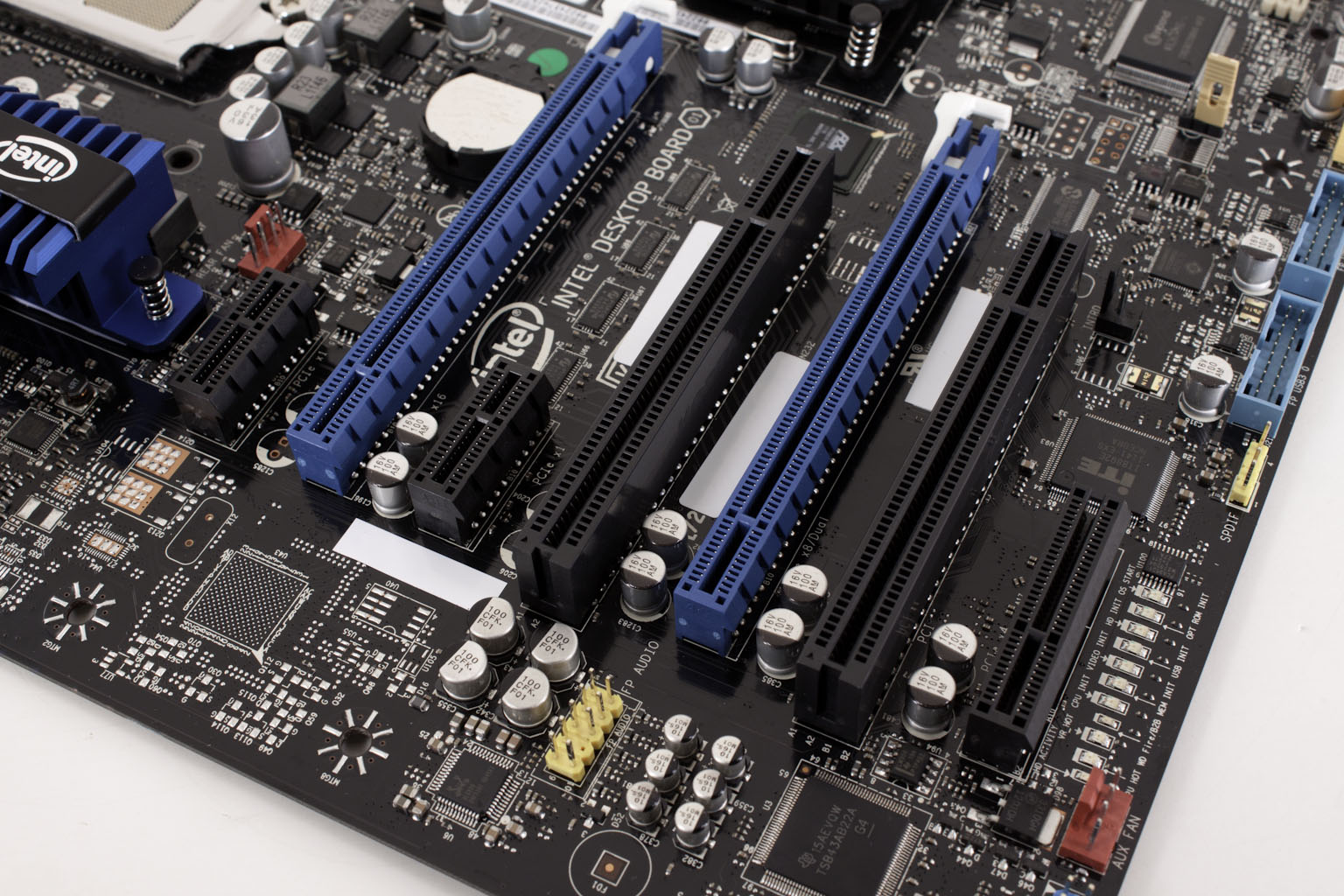
Along the front of the board you can see eight SATA ports. These break down into; two SATA 3.0 from a Marvel 88SE1972 controller (grey), four SATA 2.0 from the Z77 PCH (black) and two SATA 3.0 from the Z77 PCH (blue). There is also a Marvel 88SE1972 for the eSATA port on the i/O panel. This SATA 3.0 controller is another item that runs off of that PLX bridge that we pointed out earlier. The Z77 itself is under a small but fairly cool looking heatsink with the same electric skull icon that is on the box. With the size of this heatsink we are a little concerned about cooling at this point to be honest.
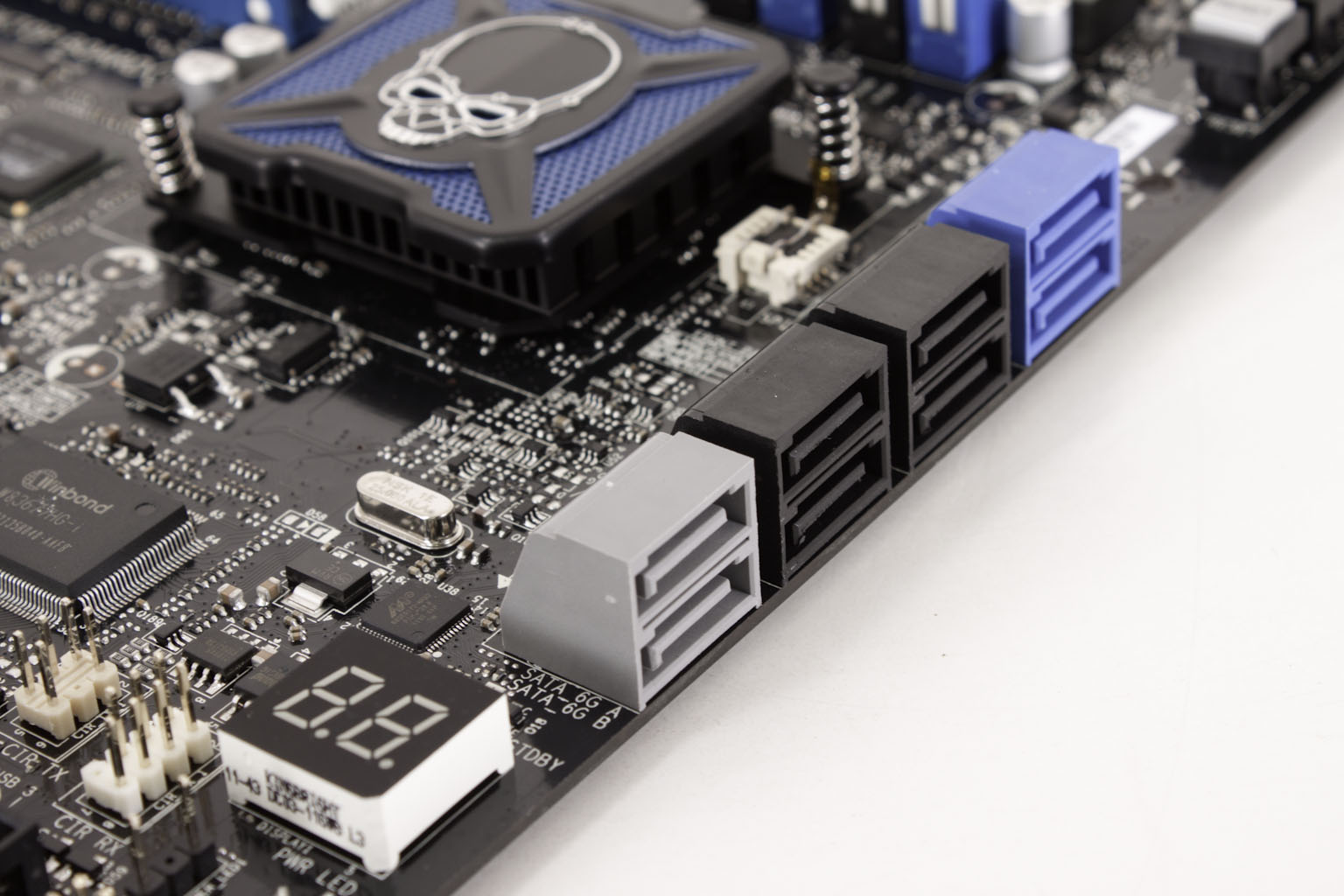 |
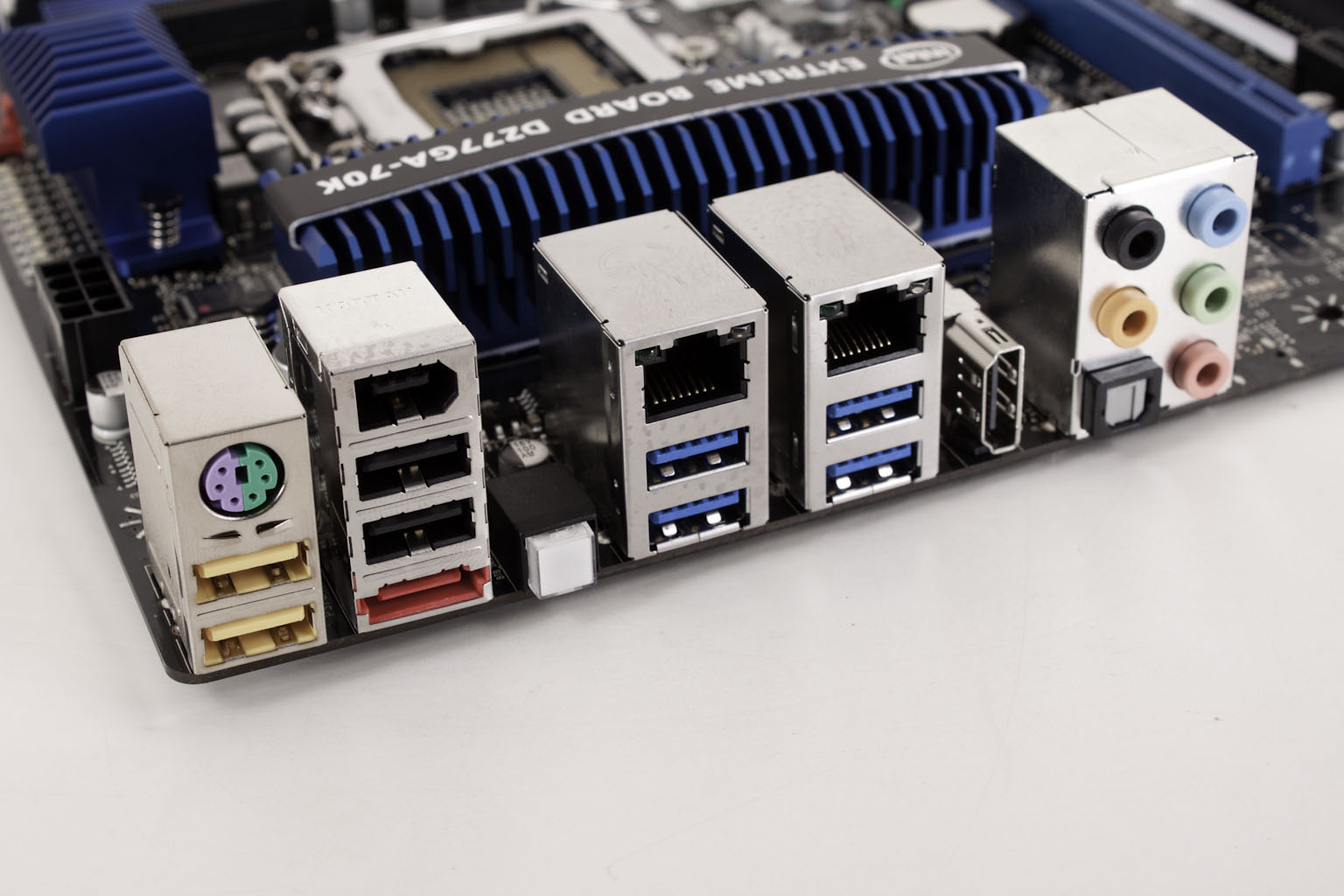 |
Flipping things around to look at the I/O panel we find a fairly typical layout (for modern boards) there are multiple USB 2.0 ports, multiple USB 3.0 ports (there are also two USB 3.0 headers on the board) All of the USB 3.0 ports are run from the XHCI controller inside the Z77 from there they run out to USB3.0 Hub chips to give you the maximum amount of USB 3.0 ports. For video output Intel has provided a single HDMI port. To round things out you get two LAN ports, a fairly typical audio out block and a “back to BIOS button”. For more information about the electrical layout of the DZ77GA-70K check out the block diagram bellow.

Features -
In the current market motherboard (and indeed almost all component) performance is very close. The days of a large performance advantage between boards using the same chipset are long gone. That is unless someone makes a HUGE mistake (like runs traces completely wrong). Now, the thing that differentiates different products is the features. These are things like power management, extra slots, better audio CODECs etc. It is these items that R&D teams work so hard to drop into what are really identical pieces of hardware at their most basic level.
Excellent -
Visual BIOS
PCIe Generation 3.0
Although there are only two features listed here, both are very good. Having support for the next generation of PCIe graphics or components is only going to improve your performance while Intel’s visual BIOS is one of the smoothest we have worked with (check out our video). If you want to see how UEFI should be done this is a great example.
In the middle (sort of good) -
HDMI 1.4 with full 3D support
Dual GBe LAN controllers
Support for 8-USB 3.0 ports
Bluetooth/WiFi
This listing of features are still solid ones, but they are not at the top of the list. There are a good number of motherboards with dual Gigabit LAN controllers, support for multiple USB 3.0 ports and also with Wireless and Bluetooth onboard. Still they are good features and add value to the board.
Floor Mats -
SLI
Crossfire
We hate to say it, Crossfire and SLI support is almost requirement these days. If you find a desktop motherboard (in the midrange or enthusiast category) that does not support these two standards there is something very wrong. We are even seeing entry level boards with this support.
BIOS -
BIOS is an acronym that stands for Basic Input/Output System. It is meant to control your product at a very low level. As of right now there are three regularly used BIOS formats (there are actually more than that but there are three common ones). These are the AMI (American Megatrends Incorporated), Award, and Phoenix. Intel has improved on their UEFI concept with what they are calling the Visual BIOS. This is something to see in action as it is possibly the smoothest BIOS we have used in a very long time. Check out our video of the BIOS below.
Overclocking –
As we covered in our full review of the Core i7 3770K overclocking with Ivy Bride as your CPU has its limitations and difficulties. Although the new Core i7 CPUs are 22nm and have a higher TJMax (thermal junction maximum not the retail store) you still have to worry about leakage at the transistor gates. The higher the frequency (and voltage applied) the more likely this is to happen. There is a bright side to this though. With the new 22nm process the cold bug is gone, this means that you can push Ivy Bridge pretty high (the record is something like 6.6GHz as of this writing 4-19), but you have to make sure things are cool to help maintain stability. Our maximum overclock was 4.8GHz at 1.339 Volts anything over that was unstable and would not complete our test run. You can see our CPUz screen shot below, but we did not validate it at the time it was run due to NDA restrictions.

Of course overclocking is a picky subject. I can buy to identical CPUs from the store and they will not always perform the same way under stress. This is the same with motherboards, RAM and GPUs. So again it is important to keep in mind that our results represent a specific hardware configuration. Yours may be similar but will rarely be identical.

Overclocking Tools -
Intel has their own overclocking tool (as you might imagine) which is very functional and actually very clean looking. When we first opened up the Extreme Tuning Utility we were a little surprised at how simple it looked, but how much control you actually have. You even have tools to monitor what your system is doing. There are tools for overclocking the CPU the memory and the GPU in addition to a page just for the CPU. Intel has also thrown in their very own stress test for the GPU and CPU to make sure everything is happy.
 |
 |
 |
The Test System and Comments -
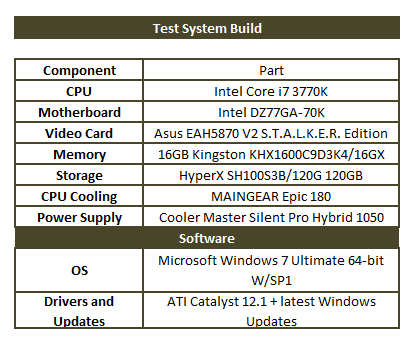
Our test system is built on an open bench. This has two effects on testing. First it allows us to see everything and also to setup and disassemble the test rigs quickly. Second it means that we cannot gauge the potential air flow found in a normal case. The air is pretty stagnant; some may say this is a great neutral testing method and it can be. However, it does mean that the temperature reading taken off of the components are not accurate to what an average consumer would see. This means that your thermal performance will vary from what we see here.
We did not have any issues with our setup of the Intel DZ77GA-70K after installing Windows 7 Ultimate x64 we were pretty much off and running. The only time we had any problems was when we tried to enable a VirtuMVP profile for PCMark7. Form some reason when we did this PCMark7 would crash or not display properly (the window would freeze until complete and then display the score). Eventually we had to uninstall both PCMark7 and the VirtuMVP software to fix this.
Performance testing overview -
Our testing is a little different than most. We combine both synthetic and real-world applications to simulate the types of performance common to the individual products. For motherboards this means that we run roughly six synthetic tests and two “real-world”. We will be expanding the real-world testing in the near future. But there is more to performance than just the raw numbers. As there are multiple components and sub-components on a motherboard there each item can have a distinct impact on the way the product will perform once you get it in your system. It is important to note not only the actual results but what they mean to you as a potential consumer. We will try to give this information to you. But we do not just cover the performance aspects that are measurable. We also talk about the components that might not have a direct benchmark. These are items like Audio Quality, ease of use and installation.
Section 1 Subsystems
Memory -
Memory performance is very important on a motherboard, especially when you have a CPU with multiple cores and threads. If you have slow memory your cores and threads can become starved for data to execute. To test memory performance we run both Sisoft’s SANDRA and AIDA64. These two combine to not only give us accurate numbers but to validate each other. For testing at stock speeds the memory is hard set to 1333MHz while overclocking testing is done at the highest stable speed for the voltage of 1.65v this is due to the different memory dividers for each CPU. As such, the memory speeds will vary greatly. This means that the overclocked numbers are a little misleading and while they can show a trend are really only included to show if a board has a problem with memory performance at high clockspeeds.
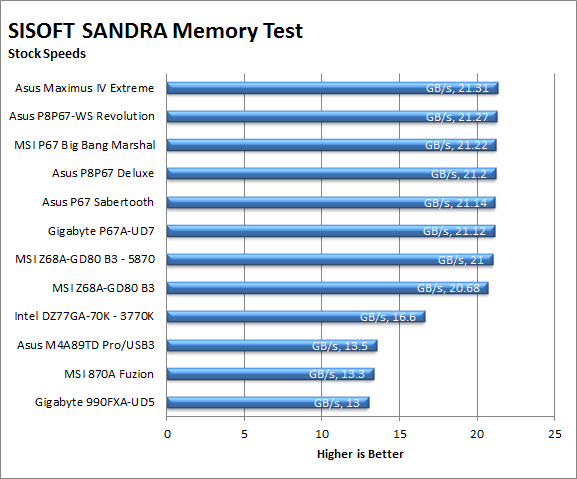
Again as we told you with our coverage of the Core i7 3770K the memory bandwidth is not what we have come to expect. Instead of being in the 20-22GB/s range we find ourselves back in the 16-17GB/s range. Normally this would be a serious concern, but we do know that the new instructions in Ivy Bridge compensate for this quite nicely. Now we just need to make sure that the rest of the board can deal with this as well.
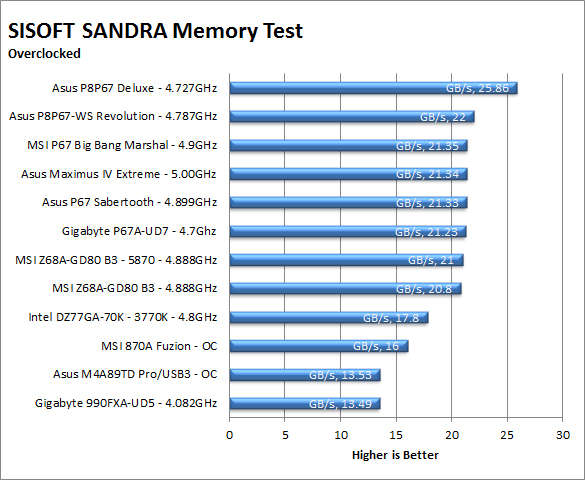
Drive performance -
Drive performance is also one of the major subsystems that goes to make up the performance of a motherboard. For our testing we use Sandra and AIDA64 again. We only test with single drives for each type of controller present on the motherboard (unless it is a professional product where we will use RIAD 5 and/or 10). We have also begun using a Seagate PS-110 USB 3 external HDD and a Kingston HyperX USB 3.0 Flash drive for our USB 3.0 performance. As a side note, we include the overclocked numbers here to make sure (again) that you are not going to see a major drop in performance due to minor instabilities at high clock speeds.

The SATA performance on the DZ77GA-70K is outstanding. Even the SATA 3.0 performance is up there although we did have to clear out the numbers for the other products since we moved to using the Kingston SATA 3 SSDs). Additionally, our testing of the USB 3.0 ports from the PCH yielded good performance with both our USB 3.0 HDD and the Kingston HyperX USB 3.0 Flash drive. Here we saw a 253 MB/s rating under Sandra
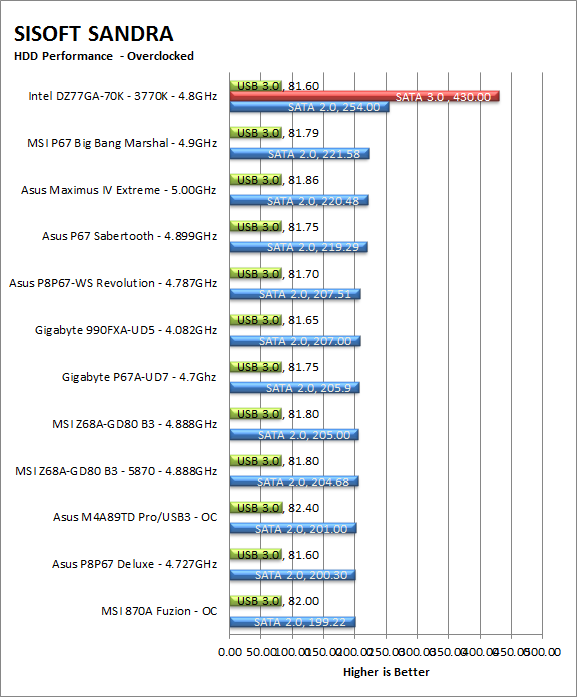
Power -
Power efficiency is another of those misnomers that we get caught up in. We hear about idle states and power gates. But what does that mean to you and I? On the surface having power management that reduces idle power sounds great and can be a benefit to someone that leaves their system on for long periods of time (and inactive) but how a system handles power under load and the delta between the two states is often more important than the idle power usage numbers. We use only P3 Kill A Watt instruments for measuring power.

For power draw the Intel DZ77GA-70K was very efficient even when we had our EAH 5870 V2 from Asus running. This is good news for people looking to maintain energy efficiency and good performance.
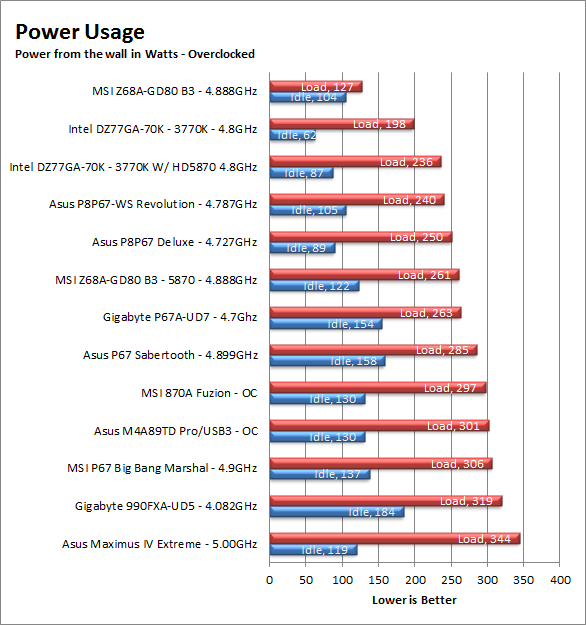
Cooling (Board Level) -
Board level cooling is an important factor in product performance and longevity. Components like the chipset, VRM modules and even capacitors need to be kept relatively cool to prevent failure. As these parts are made of silicon, they have a thermal breakdown threshold; or melting point. At that temperature the actual transistors built into chip will begin to deform and break down. Granted, the threshold is often very high, but you still need to make sure that components stay away from this level of heat for longer product life.

As we mentioned in our walk around of the board we had concerns that the Z77 PCH would get a little hot with the small heatsink. We were right to worry about this as we see it runner much hot than any other boards we have tested to-date. - Update- It appears there was an issue with our Fluke 62 Mini. The internal switch that changes the reading from Farenheit to celcius was not working as it should. we have made the calculations to adjust the temps and you can see the results below. We apologize for this as the reading still showed c in the display. However it is obvious that it was not reading properly when we used a second IR thermometer for verification after user comments

Audio -
Audio is highly subjective. What we find pleasing may sound “off” to you. That is always going to the problem with testing audio; results will vary too widely depending on the tastes of the listener. However, there are ways of measuring the audio output with an objective ear. There is also the issue of audio causing performance issues in gaming and video playback. The reason this is a potential source of concern is that all onboard audio CODECs (Compression/Decompression) are CPU controlled. This means that while the audio chip controls the audio levels and effects of the audio the actual work is done on the CPU. Usually this will not be a problem with today’s powerful CPUs. Even the lower and consumer level products can handle high-end audio these days. But again there is the chance that a bad design or software will hinder your system and performance. On the other side the limits of board space, cost, etc will also prevent the level of audio quality you can get from an add-in board. We test all audio parts with three media types, Movie (DVD), MP3 Music, and Gaming. These are pushed to our Tec On model 55 Tube Amp to see if we can detect any signal issues in the reproduction.
The audio on the DZ77GA-70K is pretty good. It will do for most things that you want to listen to, but is not going to win any awards or leave you in awe of its quality. If you need sound, this will fit the bill.
Networking -
This one is something that is a requirement anymore. If you have a computer, the chances are good (like 99%) that you are also connected to high-speed internet. With this you need a good and solid LAN chip to make sure that your data flows properly out and back.
The networking performance was another matter completely. Here we have two Intel LAN controllers which can be used independently or teamed for more available bandwidth. On the wireless side you have an external Ralink (RT8070) USB wireless device that allows you to connect to 802.11b, g, and n with a maximum possible speed of 150Mb/s. This is most likely due to it being a single antenna product which will limit the possible speeds it can run at. We found that our average connection was around 100Mb/s using the wireless devices we have in the lab.
Section II - Performance Tests, Synthetic
In this section of testing we cover the synthetics. These are tests that run a scripted sequence of internal APIs or that use another installed application to perform a series of scripted events. They are great in that they can provide reproducible results across various platforms. On the down side, synthetic tests can be fooled with driver tweaks and optimizations. In some cases it is necessary to rename the .exe file to something generic to discover if this is the case. In any event when this is needed (when a test shows a drastic difference in performance over the renamed exe) we will note this and show both results for comparison.
PCMark7 -
PCMark7 is the latest general performance test from FutureMark. As each generation of this benchmark has evolved and developed we have watched them add more and more realistic tests to this suite. With this generation we find more media tests, (audio and video transcoding) moving of large files, multiple web page rendering, and much more (the even added DX10 gaming). We use the Overall Performance and Common Usage suites in our testing.
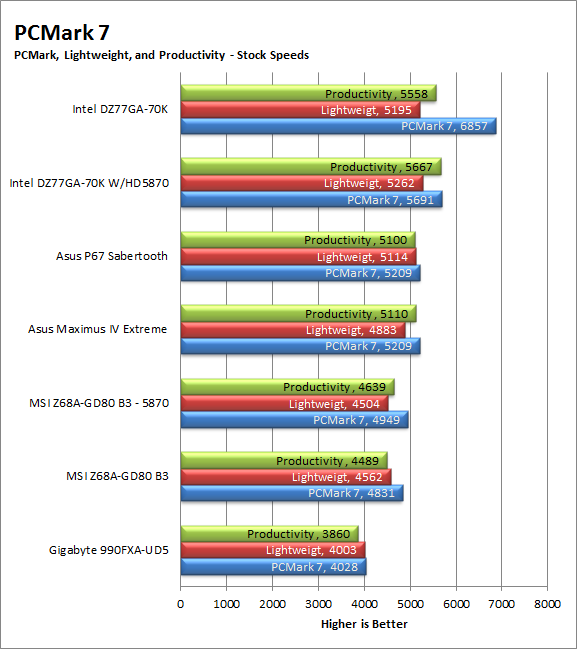
No surprises here, as you have probably already read our Core i7 3770K review you will know that the PCMark7 scores are very high due to the new AVX (Advanced Vector Extensions) in Ivy Bridge. These help to push the creativity (content creation) and Compute scores through the roof. For stock speeds we had a 23085 Compute while this jumped to 31825 at 4.8GHz using just the 3770K. When we had the HD5870 in play the numbers dropped but were still higher than any other board we have in our test group.
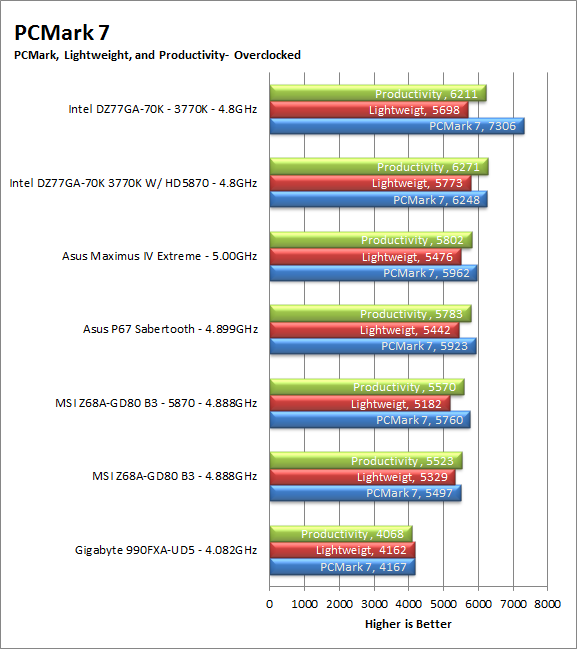
3DMark 11 -
3DMark 11 is the other Futuremark test that we run on our motherboards. This test simulates the typical tasks that a GPU (and system) would have to perform to provide you with a good gaming experience. It is based on the DX9, DX10 and DX11 engines but can only be installed on Windows Vista or later. The suite of tests covers DX9, DX10, and of course DX11 rendering; it also covers AI computations and physics. That’s right I said Physics the latest version of 3DMark uses a Havok physics engine. This removes the advantage that nVidia had with 3DMark Vantage.
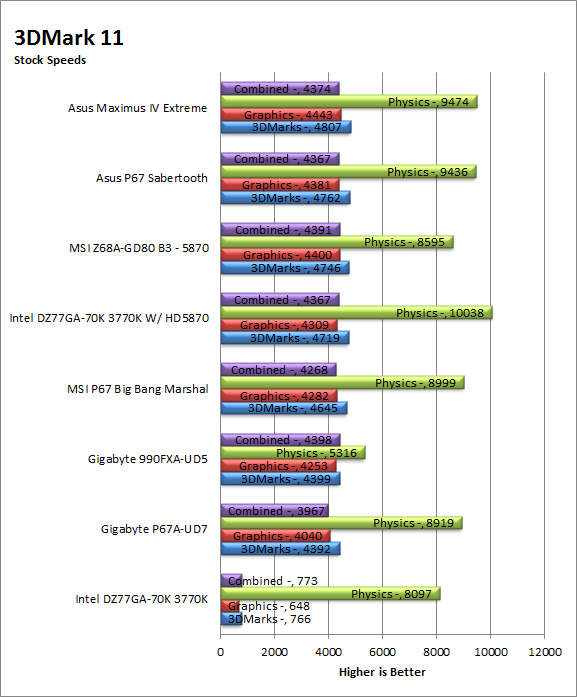
For 3DMark 11 we are finally able to use the IGP on an Intel CPU. The GMA 4000 supports DX11, but while you have support for the API you will want to remember that it is not meant for high-end gaming like Trinity or AMD’s APUs. It will get you by with mainstream gaming and a couple of more demanding games, but as you can see here it is not a powerhouse (nor was it designed to be). Still once you put in a discrete GPU things level back out.
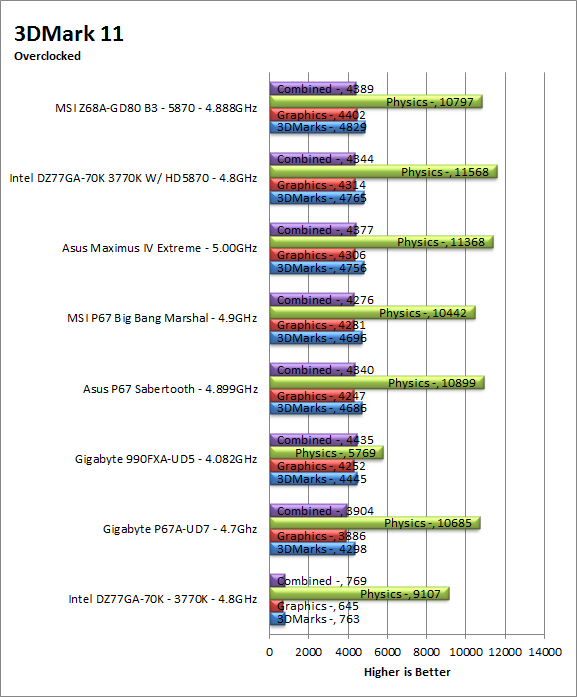
HyperPi 0.99b -
HyperPi is a front end application that allows you to easily run multiple instances of the SuperPi application. SuperPi, for those that are not familiar with it, is an application that measures the time it takes to calculate the number Pi out to as many as 32 million places. This calculation is then checked and run multiple times (up to 24 for a 32M run). This test stresses the CPU, Memory and HDD as data is handed off between the three. If there is a weak link, HyperPi will show it. For our testing we run the 32M test on as many cores (and threads) as the CPU has available. The slowest CPU time is then recorded.

Here we find out that the lower memory bandwidth that we saw it not a concern at all. You are getting some great times here. This performance is due to improvements in the way the CPU handles complex computations and also to the caching system. We would love to see what would happen if you still had 20-21MB/s of memory bandwidth available.
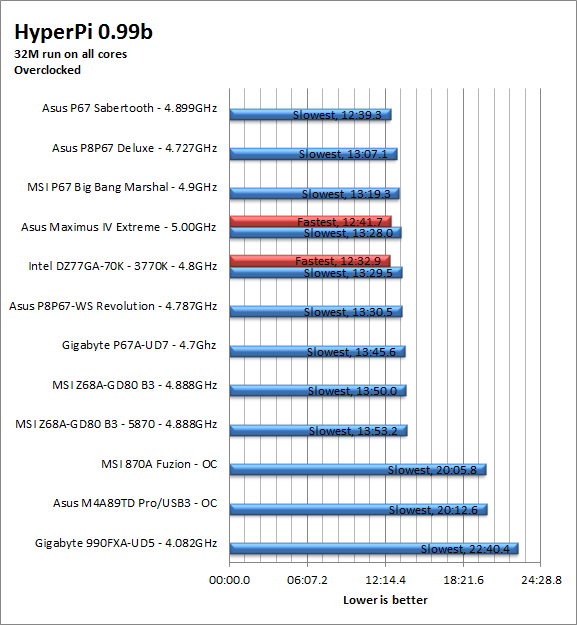
Cinebench R11.5 -
Cinebench R11.5 is the 11th release of Maxon’s rendering test. This test is based off of the Cinema 4D engine, which is one of the industry standard tools for digital animation. It is a powerful product with many different modules that can be “plugged” into it to increase its effectiveness. With Cinebench you get to see how your computer would do using this application. There are two tests; one tests the CPU’s ability to render an image across multiple cores or threads. The other tests your systems ability to handle OpenGL based rendering.
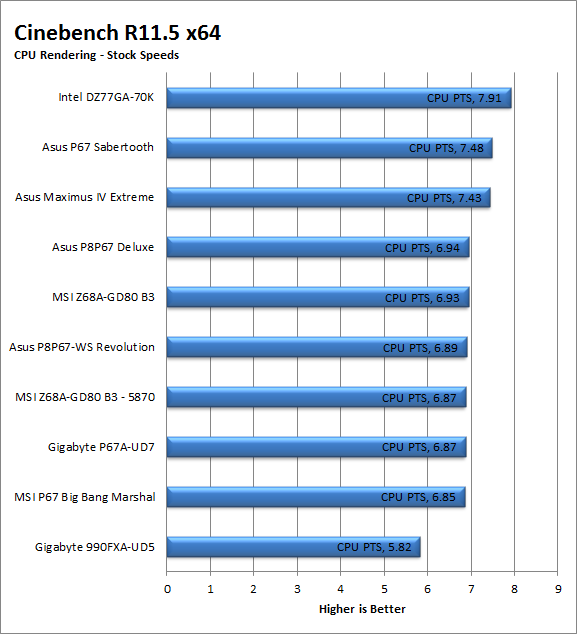
We have broken out our Cinebench scores now. This is to give you a clearer picture of the CPU and Open GL rendering from the systems in use. For CPU based rendering we found that the Intel DZ77GA-70K when combined with the Core i7 3770K does a great job at stock speed, but does not scale as well when overclocked. OpenGL render was not all that great as it is using the GMA 4000 for this. Still we can see an improvement in performance over Sandy Bridge.
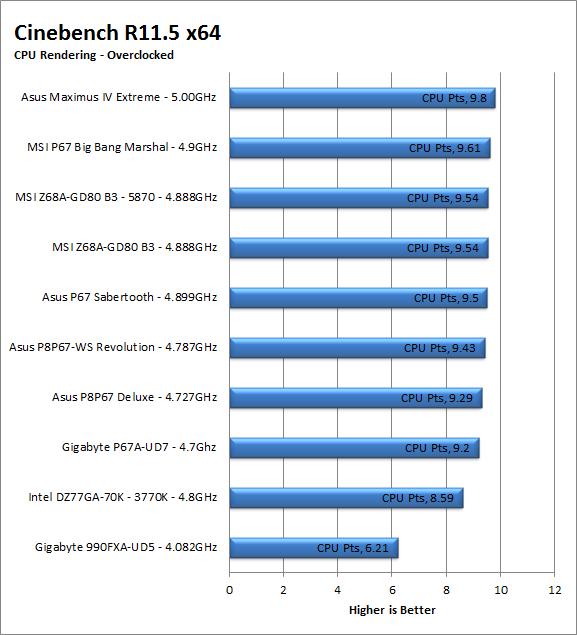
| Cinebench R11.5 OpenGL Stock | Cinebench R11.5 OpenGL Overclocked |
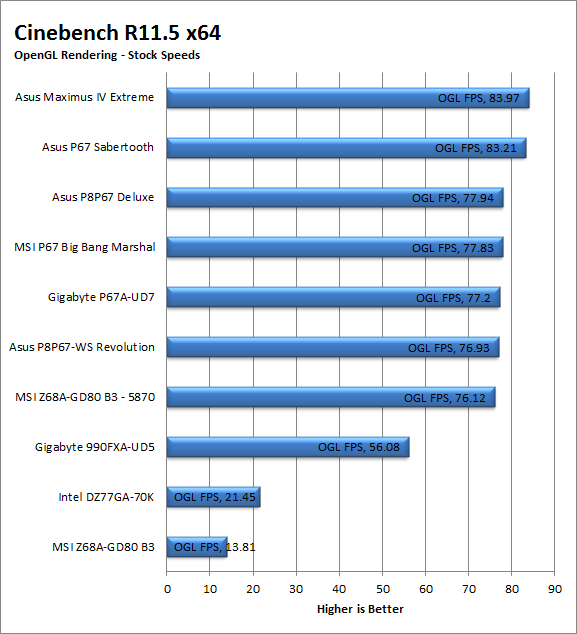 |
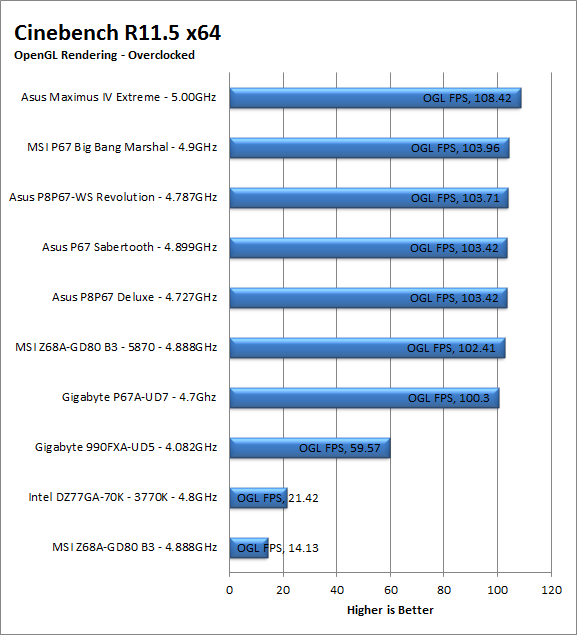 |
Section III - Performance Tests, Real-World
Here we have two tests that are designed to put the performance of the motherboard and its subsystems to the test. Both require good CPU, Memory, HDD and even to a lesser extent audio and network performance. The two tests we chose were Lightwave 3D 9.6 and AutoGK 2.55. We will be adding at least one more real-world test to this battery in the near future, but for now these two cover quite a bit.
Lightwave 3D 9.6 x64 -
Lightwave is another industry standard application for 3D animation and rendering. It has a large tool base and the rendering engine is highly threaded (when using the right render model). This application is also capable of expanding to 4k resolutions as well as ray tracing for rending the light sources. For our testing we use frame 470 of the Pinball scene found in the LW 9 Content folder. This uses the newer perspective camera that is better suited to a multi-CPU/Core environment. This camera style also uses ray tracing and a much improved anti-aliasing method. Settings are shown below in the attached screen shot. Of course these are single frame renders and they are not a complete picture; for that you have to take into account the number of frames an average project would have. In a typical 30 second commercial you will have around 840 to 960 frames (at 28 – 32 FPS) this means that you have to multiply the time of a single frame by that number just to get a vague idea of how long that 30 seconds would take. This is because each frame will have a different render time based on complexity.

Again we see the improvements of the CPU more than the actual motherboard, but we can also see some of that her as well. The Intel DZ77GA-70K manages to stake out a spot at the top of the list for stock performance, this time we do not see the same scaling issues we saw under Cinebench which is a good thing.
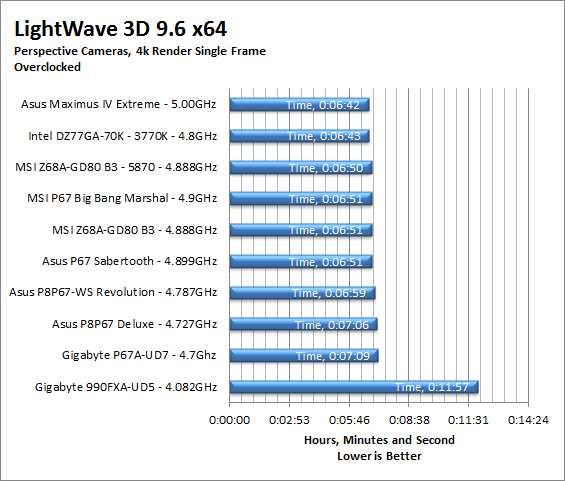
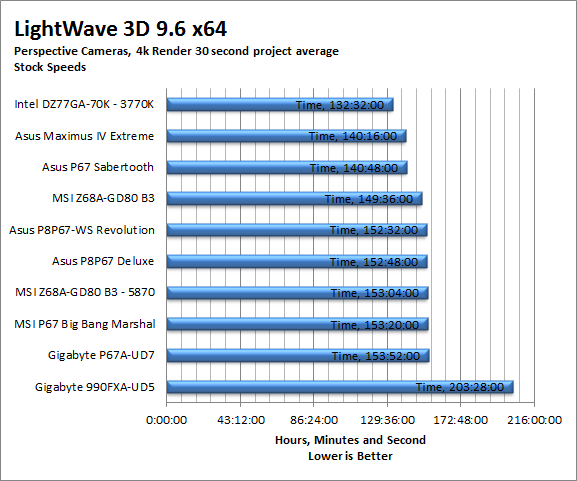
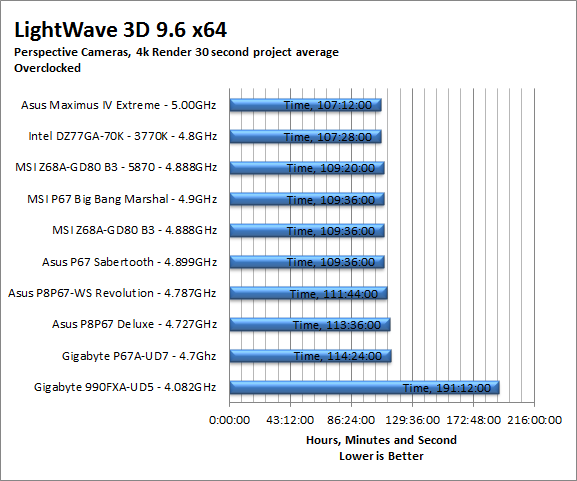
CyberLink Media Espresso 6.5 -
After having various issues with AutoGK and Intel CPUs with more than four cores we have changed our Media Encoding test to use Media Espresso from CyberLink. Although this new utility does not have the same ability to transfer directly from DVD it is still a good test to transfer different media types into a usable format for your iPad, iPod, or other media player. Our test involves using multiple (Six) 20 minute media files and transcoding them for an iPad. This gives us a very good indication of how well a motherboard can handle this type of work load.
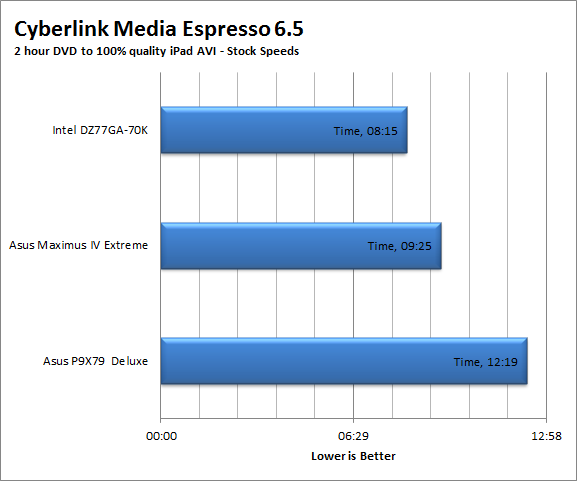
No surprises here as we see the AVX sporting Ivy Bridge run away with the show. It also does not hurt that the GPU is coming into play to help speed things along
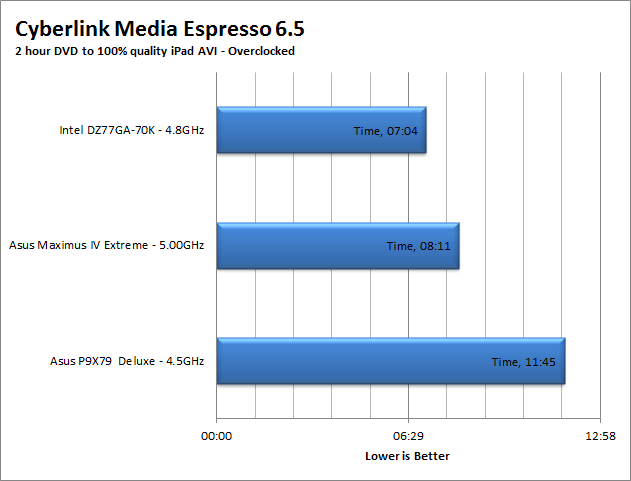
Section IV Performance – Gaming
Gaming as a test of motherboard performance is sort of a joke these days. The big player in the gaming arena is the GPU. Everyone but a few hardcore PR teams know this. However, it is important to run at least a few (one from each current DX version) to see if there are any issues with the combination of components on a motherboard. These are items like Audio lag, memory lag and of course problems with the PCIe lanes and signal traces. If there are issues in design, drivers or BIOS then you can have odd gaming performance. So without much more preamble let’s dive into the three games we currently use; Call of Duty Modern Warfare 2 for DX9 FarCry 2 for DX10 and Battlefield Bad Company 2 for DX11.
Call of Duty Modern Warfare 3 DX9 -
As the third installment in the Modern Warfare franchise you are picking up some old roles while adding a couple of new ones as well. The game play is almost identical to what you are used to in Modern Warfare 2 as are the graphical settings. The AI is a little different thought it is still similar to the bar fight style AI we like in the Call of Duty series. For our testing we run the first mission (Black Tuesday) from start to finish. Settings are shown below
 |
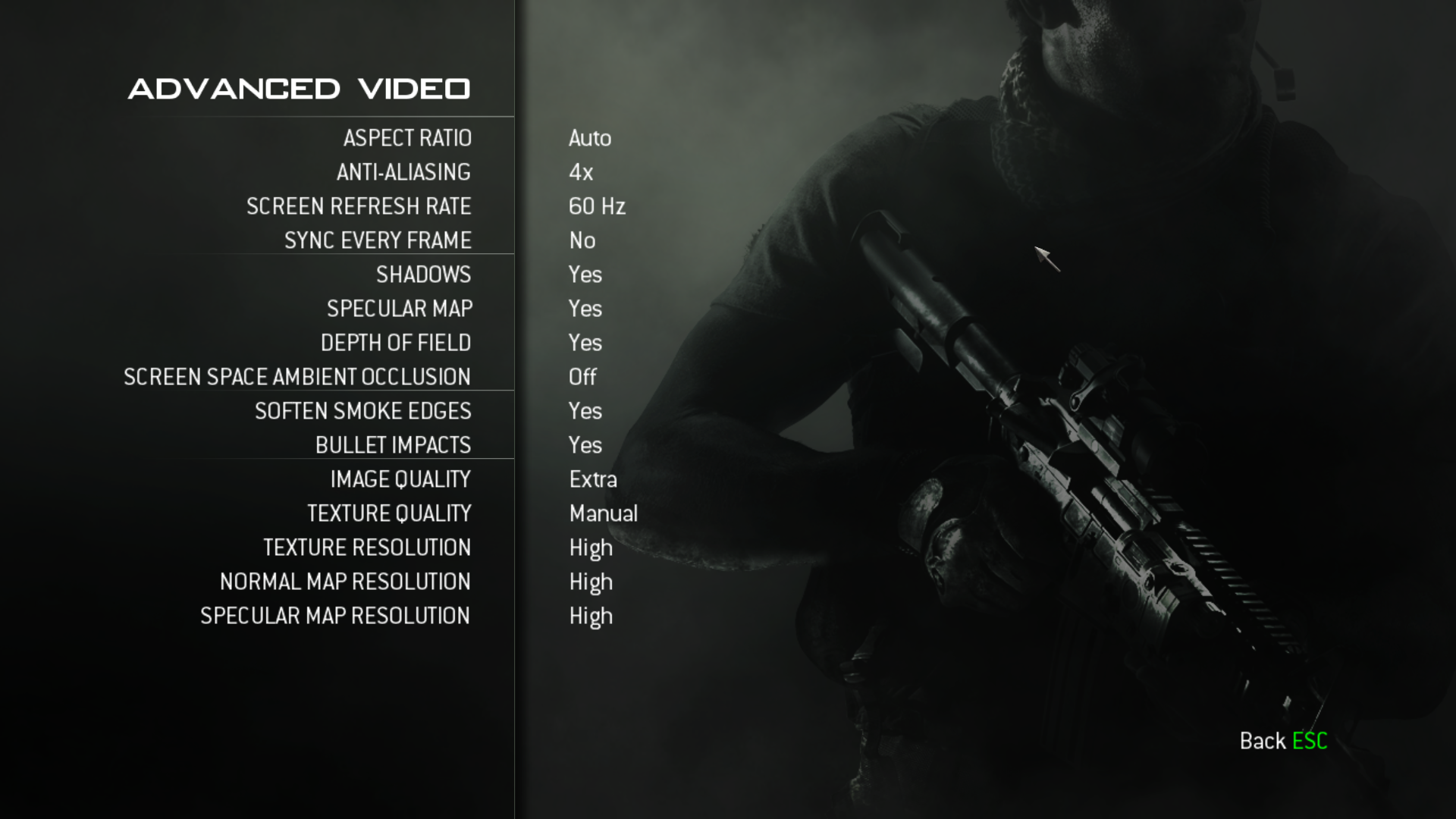 |

Call of Duty Modern Warfare 3 was actually rather playable on the GMA4000 even with things set to high. We were more than a little impressed even though this is an older DX9 title we still did not expect to see this level of playability. Once we dropped in our 5870 we can see that the DZ77GA-70K is no slouch for gaming.
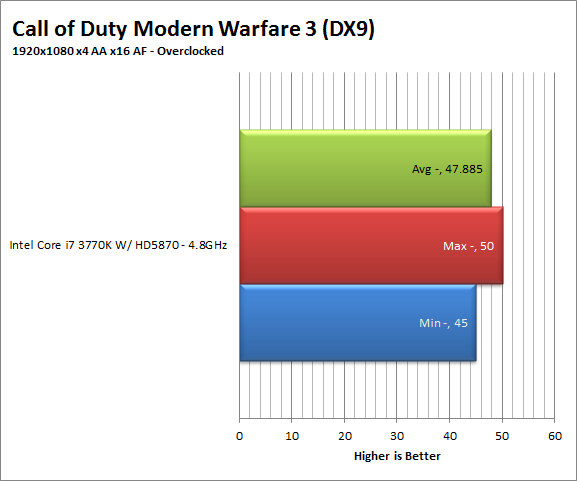
FarCry2 DX10 -
Although not one of my favorite games this tedious game does have some good graphics. The large sandbox style of the game lends to mission based play. The only problem is that the AI is rather low grade. Still the more CPU power the more the bad guys try to do. Over all the game was a little bit of a disappointment to play, but still not a bad DX10 representation. Our testing run starts right after you get your first mission to clean out the safe-house and ends after the hostage rescue. Settings and performance numbers are shown below.

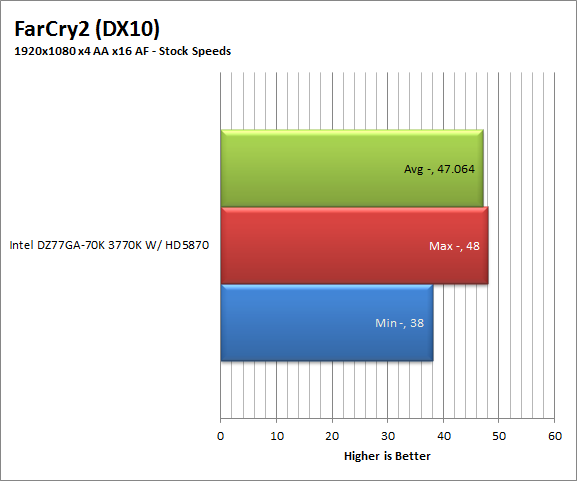
FarCry2 was much more of a drain on the system as the DX 10 engine kicked in and put a hurting on the GMA 4000 built into the Core i7 3770K. Things turned around with our 5870 in the system though.
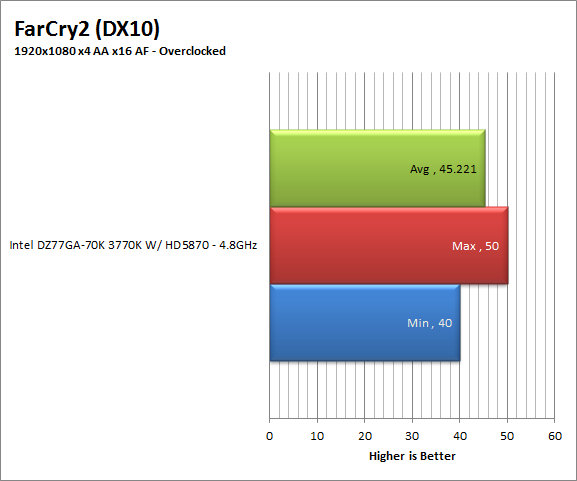
Crysis 2 DX11 –
Another sequel Crysis 2 follows up on two other Crysis games (making the title a little misleading). You take the role of a Force Recon Marine who is given a battle suit by a character named Profit (you will remember him from the other two Crysis games). From there you run around an Infected and Invaded New York City trying to survive and, of course, save the planet. For our testing we ran through the first “mission”. Settings are shown below.
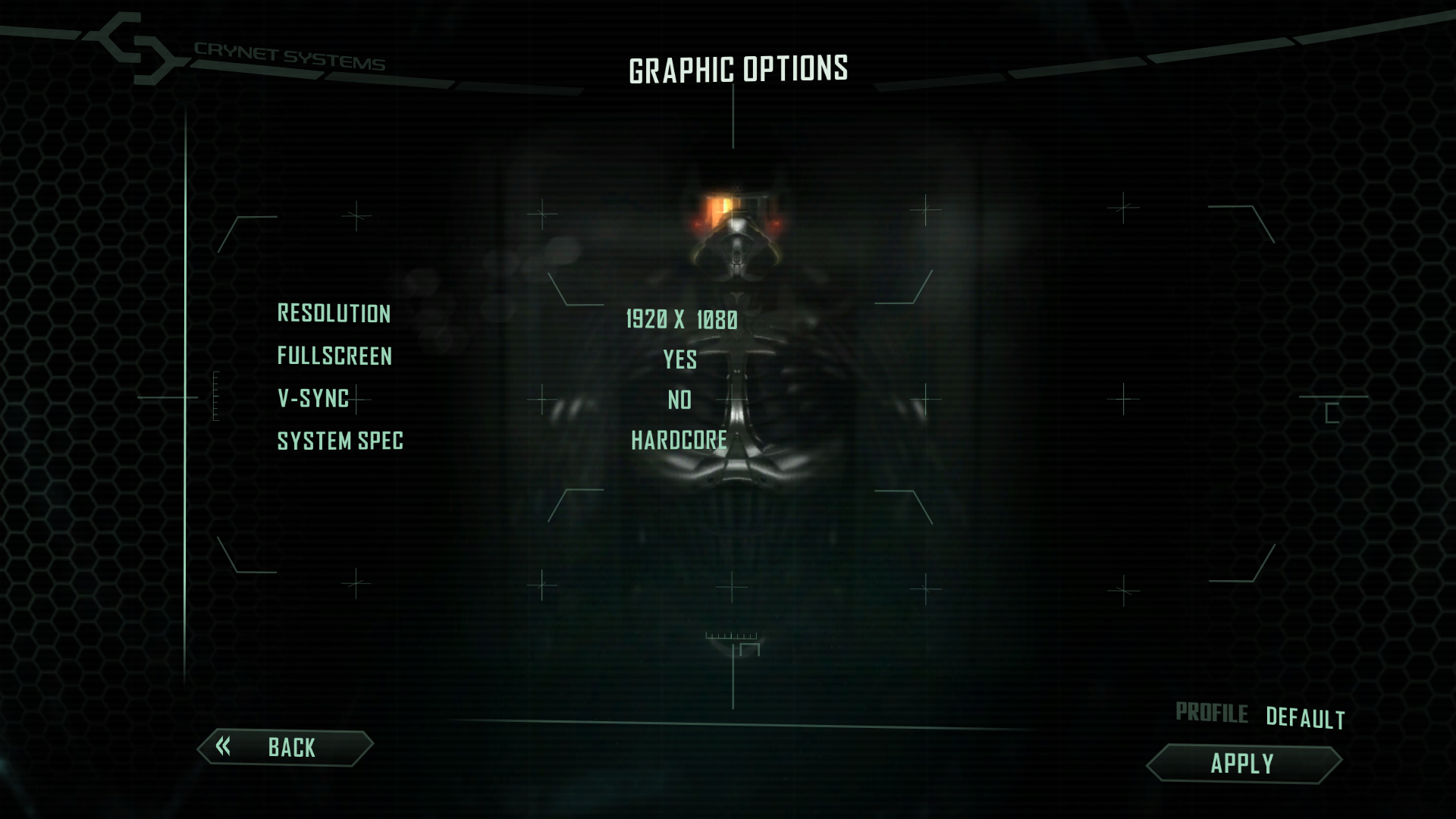

As you might imagine the CryEngine in Crysis 2 combined with the DX11 API brings the GMA4000 to its knees. Again it is important to remember that the GMA 4000 is not meant to be a high-end gaming GPU, that is what AMD and nVidia have their enthusiast products for. When we dropped in our Asus EAH5870V2 our gaming performance was back up to where it should be.
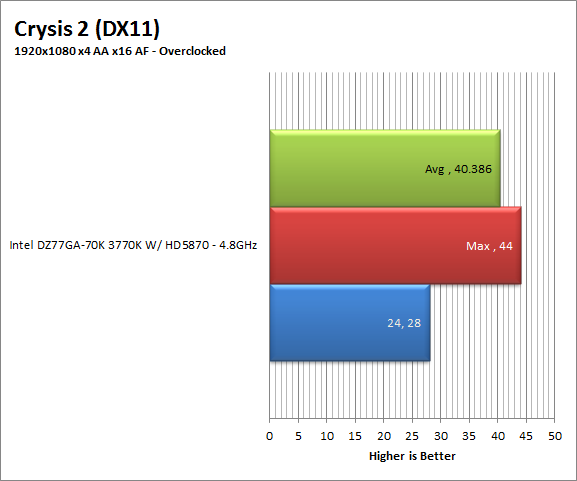
Gaming wrap-up -
The Intel DZ77GA-70K is not a bad board to game with at all. The frame rates were more than acceptable if you had the right GPU installed while the SATA controllers are capable of giving you good install and level load times. Unfortunately the audio was not as good as it could have been so you will not have the same level of audio emersion that you could have with a better audio card (or CODEC). Still on the basic performance end all of the game we used for testing played well without any problems. If online gaming is your thing you are still covered with two LAN ports and the RaLink USB wireless device.
Value -
Value is another very subjective topic. What is expensive to some might be a deal to others. You can look at this topic in multiple ways. One is raw price and the other is what you get for the money. Each is accurate and both are correct ways to look at price/value. We tend to look at features, performance and real-property when we discuss value. However, we also take into account the raw cash cost of the item. At $239.99 from most online stores the DZ77GA-70K might seem a little pricey. In a way it is sort of pricey, but you are getting a fair amount of product for that money. You are not only getting PCIe 3.0 support, but support for the new 22nm Intel CPUs and more. In the end it is not a bad deal, but you might want to look at some of the other Z77 boards depending on what you want to do with your new Core i7 Ivy Bridge CPU.
Conclusion -
We have always liked Intel motherboards for their stability and actual quality. If you are buying Intel then you know you are going to be able to use all of the features that come with Intel products without any issues. There are better performing boards out there, but in the end if you want to see how an Intel CPU is supposed to perform you can always look to the level of performance you get from their desktop boards and see. That having been said we did like the DZ77GA-70K for the features and performance we saw (especially running compute functions on the GMA 4000). The Visual BIOS is very slick and clean. There are a few companies that I know of that should take a look at this new BIOS and see how it is done. All that aside this is not a board for everyone. You are not going to get amazing overclocks out of it and while it can game there are things that need improving before we would call it a gamer’s board. Still we can see how the Z77 chipset should run and we will use this as our baseline in our continued coverage of both Ivy Bridge and the Z77 chipset.
Discuss this in our Forum

 Although the Intel Z77 Express chipset has been available for a while now we chose to wait until the official launch of Ivy Bridge to begin our reviews. After all the Z77 with Panther Point was designed to get the best performance when tied with Ivy Bridge so why not show that off first. To kick off our coverage of the Z77 we deiced to try out Intel’s reference design in the DZ77GA-70K. This performance desktop board from Intel is a great starting point and will give us the feel of how Intel meant things to work. So let’s get to it shall we?
Although the Intel Z77 Express chipset has been available for a while now we chose to wait until the official launch of Ivy Bridge to begin our reviews. After all the Z77 with Panther Point was designed to get the best performance when tied with Ivy Bridge so why not show that off first. To kick off our coverage of the Z77 we deiced to try out Intel’s reference design in the DZ77GA-70K. This performance desktop board from Intel is a great starting point and will give us the feel of how Intel meant things to work. So let’s get to it shall we?


